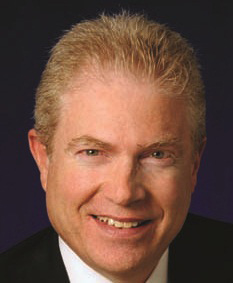BEC Widens Focus on Broadcast Technologies
LAS VEGAS—The broadcasting industry is undergoing unprecedented fundamental changes—and engineers are the people expected to somehow make these changes work. In response, the Broadcast Engineering Conference held during the 2016 NAB Show this month, is offering a wide-ranging slate of sessions that address these cutting-edge changes head-on.

John Marino
“There is not one specific focus this year for the BEC, since there are so many important issues upfront for the industry,” said John Marino, vice president of technology for NAB. “We are covering new technology developments, ATSC 3.0, digital radio, broadcast workflows, cybersecurity, emergency preparedness, UHDTV, broadcast facility design and much more. Many of these topics will be represented on the NAB Show exhibit floor as vendors look toward the evolution of radio and television broadcasting.”
AUCTION ANGST
One change keeping U.S. TV engineers up at night is the FCC’s plan to ‘repack’ the broadcast spectrum; moving some broadcasters out of their assigned channels so that this spectrum can be re-sold to the highest bidder. On Monday, April 18, 2016 at 10:30 am in S226, IABM CTO Stan Moote will moderate a vendor panel poised to answer the question, “Are We Really Ready for Repack?”
“The repack process, which is really broadcast spectrum reduction, has many variables and will impact approximately 1,200 TV stations,” said Moote. “This is very destabilizing because during this process it is extremely difficult to firm up 2016 business and technical planning. Putting the unknowns on the table in a common forum will help attendees understand repack in detail.”

For broadcasters, the FCC’s spectrum auction “timeline is the most pressing issue.” Moote said. The fact that the auction could force some stations out of their current channels means that broadcasters have a lot of questions that need to be answered, and fast. To help out, “the complete supply chain to make the repack change-over will be examined for stumbling blocks” during this BEC session,” Moote said. “The panel will also be asked questions: How will channel sharing work? In what way will the transition to ATSC 3.0 fit into the mix? What about LPTV? Will coverage and interference patterns change? Is repack realistic?”
Get the TV Tech Newsletter
The professional video industry's #1 source for news, trends and product and tech information. Sign up below.
That’s not all: BEC attendees can hear from “several manufacturers discussing issues such as transmitter upgrades, antennas, filters and the availability of tower crews to do much of the work needed at facilities to accommodate a spectrum repack,” said Marino. “Also to be addressed are the many challenges involved to provide uninterrupted service while making a channel transition.”
ANTICIPATING ATSC 3.0
ATSC 3.0 is also on the BEC’s schedule, thanks to the new opportunities this new HDTV standard offers to broadcasters. Because many broadcasters still don’t know about all of these possibilities, plus the timeline associated with ATSC 3.0’s rollout, “we have a half-day scheduled that will focus on field test results, single frequency networking, the impact of the ATSC 3.0 waveform on existing transmitters and ways that this new wireless IP delivery platform will revolutionize television broadcasting,” Marino said.
Scheduled for the Sunday afternoon April 17th, sessions will include “ATSC 3.0 – It’s More than Just Television.” The 5 p.m. session will be presented by GatesAir CTO Rich Redmond in S219 of the LVCC and will explore the possibilities of ATSC 3.0 as a wireless IP platform.

“Much of the discussion around ATSC 3.0 has been the delivery of UHD/4K content, including HDR content,” Redmond explained. In fairness, “this is indeed a great use of the technology, and 4K HDR content is very compelling. In many ways this is a similar proposition to the original concept of ATSC 1.0: A better video experience, but basically the same linear TV model as before in analog with some enhancements.”
At the same time, “ATSC 3.0 really changes the paradigm in that it transforms a TV station to a wireless broadband, one-to-many IP delivery platform,” Richmond noted. “In the TV business there is nothing that has the potential to transform station businesses more than the flexibility of ATSC 3.0 and a cost-effective wireless IP delivery system. Attendees will see a number of potential new business services they could achieve via ATSC 3.0.”
PROTECTING THE CONNECTION
As broadcasters move into the IP world—not just through ATSC 3.0, but also on the Web and mobile—they are finding themselves within the gunsights of hackers. This is why the BEC will delve into cybersecurity and digital content protection for radio and TV operators; issues that were of no concern to broadcasters not so long ago.
“With the high-profile cyberattack on TVMonde in France and a variety of ransomware and RDS attacks on radio broadcasters, cybersecurity is a major issue that broadcasters need to follow and prepare for,” said Marino. “Many broadcast facilities are connected to the Internet; making them vulnerable if steps have not been taken to secure their critical infrastructure.” (Editor’s note: Last June, “Jihadists” launched a cyber attack on French broadcaster TVMonde that resulted in an eight-hour blackout that cost the network a reported €4.6 million.)
To remedy this, BEC’s cyber security sessions on Wednesday, April 20th will cover many of the options available for the industry to secure its assets—as well as “best practices.” For instance, Bentley University professor Steve Weisman will delve deep into the dark realities of cyber-security with his session, “How Worried Should You Be of a Cyberattack? Very!” at 5:30 p.m. in S228.
“The main focus of my presentation is that radio and television stations are prime targets for a myriad of hackers with different motivations,” said Weisman. “Some may be hacking station websites and computers to temporarily take control of these media to embarrass the stations for political reasons, while other more profit-inclined hackers may be looking to lock the computers of the stations using ransomware, threatening to destroy the stations’ data if they do not pay a ransom.”
The dark motives for cyberattacks on broadcasters don’t end here. Many attacks can target broadcasters simply because they are commercial enterprises. “Still others will be seeking to steal information including W-2s and other personal information for purposes of income tax identity theft or other forms of identity theft,” Weisman warned. “Stations will also be the target of attacks to steal access to stations’ bank accounts or to lure the stations into paying phony invoices.”
The real problem is that broadcasters are being targeted by hackers due to their vulnerability, perceived social power and presence, and ability to deliver up profitable financial goodies to criminals. The fundamental motivation for attacking broadcasters is akin to the reason bank robber Willy Sutton is reputed to have given reporters when asked why he robbed banks: “Because that’s where the money is.”
When it comes to cyberattacks on broadcasters, “such stations represent desirable targets for these hackers, often because the stations may not have paid sufficient attention to preventive actions including employee education,” said Weisman. “The main issues I intend to raise is to first identify from where the threats are coming, what are the various threats and the often simple steps that can be taken to reduce the likelihood of a devastating cyberattack.”
DISCUSSING DRONES
These are just some of the important topics scheduled for this year’s BEC. Also on the agenda is the use of UAVs (aka drones) for newsgathering; an approach that offers bird’s-eye views of events (including those where police have blocked ground access) at a time when the FAA is still ironing out the legalities of flying unmanned, remotely-controlled aircraft within U.S. airspace.

In June 2015, “Jihadists” launched a cyber attack on French broadcaster TVMonde that resulted in an eight-hour blackout that cost the network a reported €4.6 million. The BEC will delve into cybersecurity and digital content protection for radio and TV operators. “We have a panel session covering drones and their uses for newsgathering; what broadcasters need to know about FAA and legal issues, and overall guidance for broadcasters,” said Marino. “In this session will be presentations addressing radio and television coverage in conflict zones, efficiencies in newsroom production, new techniques to cover sports events, and ways that IP technology is improving work in the field.”
OTT will also be covered at this year’s BEC. Mindful that broadcasters are moving into OTT content delivery, “our OTT session will cover ways to improve streaming video and protect content,” Marino said. “A presentation by TV Globo Brazil will describe how this large broadcaster developed an OTT platform customized for their viewers.”
All told, the NAB 2016 Broadcast Engineering Conference promises to give delegates an up-to-date comprehensive briefing on the fundamental changes shaping the broadcasting industry today. In addition, “we hope that attendees will take time to learn about the opportunities that are becoming available for broadcasters by way of the educational sessions that we are offering this year,” said Marino. “These BEC sessions, combined with the many exhibitors at this year’s NAB Show, will be an ideal way for attendees to learn and have hands-on experiences with products and applications on the show floor.”
For more details, visit www.nabshow.com/attend/broadcast-engineering-conference.
James Careless is an award-winning journalist who has written for TV Technology since the 1990s. He has covered HDTV from the days of the six competing HDTV formats that led to the 1993 Grand Alliance, and onwards through ATSC 3.0 and OTT. He also writes for Radio World, along with other publications in aerospace, defense, public safety, streaming media, plus the amusement park industry for something different.

